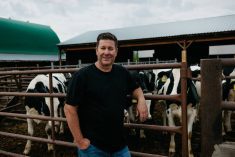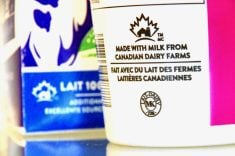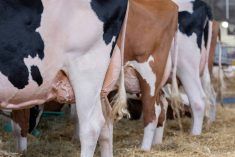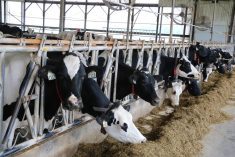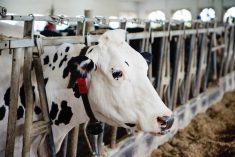No one likes to see milk being dumped, but it’s been an unfortunate part of the COVID-19 story. Dairy farms across North America have been dumping milk — and making headlines because of it.
It’s a consequence of unprecedented swings in demand, said Karlee Conway, a spokesperson for Alberta Milk.
“We’re just finding that consumer demand is impossible to predict right now,” she said.
In the early stages of COVID-19 pandemic, retail sales soared as consumers began stocking up, with some panic buying. But with restaurants, school cafeterias, and other food businesses closing, that section of the marketplace nearly vanished overnight.
“There were issues in the supply chain, and things weren’t functioning as they should,” said Conway.
Conway didn’t have figures on how much excess milk there is in the province, but Alberta Milk officials are doing what they can to minimize the amount, said chair Tom Kootstra.

“The transportation staff are in consultation with the processors… not only in the province, all the way across Western Canada from Victoria to Winnipeg,” said the Pooka-area dairy producer. “If they have a plant that is getting capacity, that gets the milk and once that is saturated, there’s no home for it.”
Producers in some provinces are disposing the excess on their farms, but Alberta Milk is continuing to pick up all the milk and just slating some for disposal in approved disposal sites across the province.
“One of the sites is a biodigester in Lethbridge,” said Conway. “So some residents of Lethbridge are getting their electricity from raw milk. That’s a silver lining in this unfortunate situation.”
Read Also

Farming Smarter receives financial boost from Alberta government for potato research
Farming Smarter near Lethbridge got a boost to its research equipment, thanks to the Alberta government’s increase in funding for research associations.
On April 7, Alberta Milk’s board told farmers they would need to reduce production and issued a quota cut of three per cent and a two-day credit restriction.
“Every province is taking some kind of action in regard to making sure the supply matches demand,” Conway said April 8. “We’re taking action so that this is really temporary. We’re hoping it’s going to end next week.”
Unlike products like grain or potatoes, milk has to be marketed immediately and cannot be stored. Still, it’s a situation that consumers have trouble understanding, especially if there are occasional empty shelves in the dairy aisle, she acknowledged.
“There’s a little disconnect that’s happening there,” said Conway. “We’re trying to work with the entire supply chain to make sure the shelves are filled. COVID-19 has been disrupting everything, so we’re trying to adapt as quickly as we can.”
If there is a need to reduce production over the longer term, there are steps producers can take — such as drying off cows due to calve sooner than normal or through culling.
“There are some feeding strategies that one could implement,” said Kootstra. “While it may reduce production short term, if we’re in the position where we must ramp up production, these cows will not go back into peak production once we’ve closed the tap a little bit.”
Milk dumping has been hard for everyone to deal with, said Conway.
“Farmers are trying to adapt to what their new normal is,” she said. “There’s an anticipation that with COVID-19, we can try to go back to our new normal. There’s a lot of hope there. It could have hit our industry a lot worse and maybe it still could. But most farmers are feeling grateful — it could have been a lot more damaging.
“It’s another way that farmers need to adapt. Farmers are incredibly important during this time, but they’re not immune to the effects of COVID-19.”
It shouldn’t be forgotten that the milk supply imbalance is a sign of how hard the owners and staff at restaurants, ice-cream shops and other food-service businesses have been hit, said Kootstra.
“Why are markets depressed today? The food-service industry collapsed overnight,” he said. “There are a lot of people in that industry who are heartbroken and depressed by that dynamic. We’re sharing this pain with many.”
There are about 500 dairy farmers in the province producing more than 800 million litres of milk annually, according to Alberta Milk’s most recent annual report.




